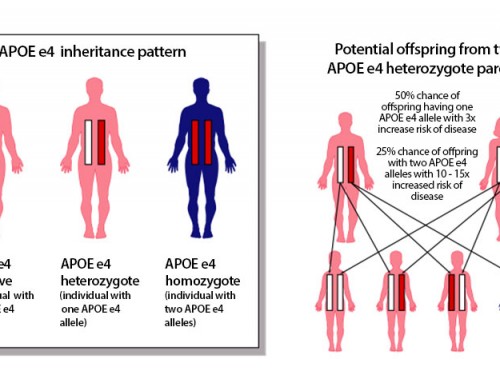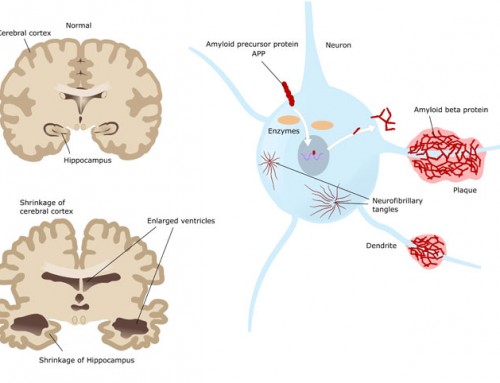[Updated 2015 Sep 24]. In: Pagon RA, Adam MP, Ardinger HH, et al., editors. GeneReviews® [Internet]. Seattle (WA): University of Washington, Seattle; 1993-2015.
Goldman JS, Hahn SE, Catania JW, LaRusse-Eckert S, Butson MB, Rumbaugh M, … Bird T (2011). Genetic Counseling and Testing for Alzheimer Disease: Joint Practice Guidelines of the American College of Medical Genetics and the National Society of Genetic Counselors. Genetics in Medicine, 13(6): 597-605.
What are the factors associated with Alzheimer’s Disease risk?
Staying healthy with a balanced diet and regular activity is important in maintaining brain health, and it can help to reduce dementia and Alzheimer’s risk. There are several risk factors that can contribute to the probability of developing Alzheimer’s disease. Alzheimer’s disease risk factors can be divided into two groups, modifiable and non-modifiable.
Modifiable risk factors for Alzheimer’s disease include cardiovascular diseases, high cholesterol, diabetes, hypertension, smoking, obesity, high homocysteine levels, depression, head trauma, excessive alcohol intake and lack of mental inactivity. These factors can be reduced through changes in lifestyle and medical treatment if necessary.
Cardiovascular Disease
People with cardiovascular disease, such as stroke and heart disease, are more likely to develop Alzheimer’s and vascular dementia. This may be due to the overlap in major modifiable Alzheimer’s risk factors between cardiovascular diseases and Alzheimer’s, such as high cholesterol, hypertension, diabetes, smoking and obesity. Latinos and African-Americans have a higher risk in developing Alzheimer’s, as they also have a higher risk for cardiovascular diseases.
High Cholesterol
People with high total cholesterol mid-life and late-life are more likely to develop Alzheimer’s compared to those with normal cholesterol level. Research has shown that people with high cholesterol can lower their risk of developing Alzheimer’s after treatment with cholesterol-lowering drugs (eg. Statins).
Diabetes
Research has shown that people with type 2 diabetes have a 65% increased risk of developing Alzheimer’s disease, compared to those without diabetes. The risk factor can be reduced by maintenance of blood glucose levels with medications.
Hypertension
Middle-aged people with high blood pressure (hypertension) are more likely to develop dementia, compared to those with normal blood pressure, as hypertension can affect the heart and blood circulation. Research has shown that people with hypertension can reduce their risk of Alzheimer’s with physical activity, a balanced diet and medications.
Smoking
Research has shown people who smoke are 45% more likely in developing Alzheimer’s compared to non-smokers. By cutting down on cigarette smoking, the risk factor for Alzheimer’s can be reduced.
High Homocysteine Levels
Homocysteine is a naturally occurring amino acid by-product from metabolic reactions in the body. Research has shown that elevated homocysteine levels are associated with an increased risk of developing Alzheimer’s, as accumulated homocysteine can cause cell damage. Homocysteine levels can be reduced via diet and vitamin supplement such as vitamin B6, B12 and folate.
Obesity
Obesity is associated with an increased risk for developing Alzheimer’s. Obesity and lack of physical activity are both risk factors for diabetes and hypertension, which in turn, are also Alzheimer’s risk factors. Therefore, increasing physical activity and treating obesity, can help to lower the risk of developing Alzheimer’s.
Depression
People who have had depression or experience depression in later life are more likely to develop Alzheimer’s. Some researchers believe that depression is an Alzheimer’s risk factor, while others believe it could be an early symptom of the disease.
Head Trauma
Research has shown that people who have had repeated or severe head injuries are more likely to develop Alzheimer’s, compared to those who have not had any head trauma. This risk factor is also increased if the head injury was severe enough to cause a loss of consciousness.
Excessive Alcohol
Alcohol is one of the important risk factors for diseases such as cancer, cardiovascular disease and dementia. People who have an excessive alcohol intake have a high risk of developing Alzheimer’s. Surprisingly, drinking alcohol in moderation appears to provide some protection against Alzheimer’s, as these individuals have the lowest risk of developing Alzheimer’s compared to those who do not drink any alcohol at all.
Lack of Mental Activity
Research has shown that a lack of mental activity is associated with an increased risk of developing Alzheimer’s. The mechanisms remain unknown, but if the brain is regularly challenged with activities, such as playing musical instruments, playing puzzles, reading or having a higher education, it is associated with a lower risk of developing Alzheimer’s.
Non-modifiable risk factors for Alzheimer’s disease are age, family history, genetics and gender.
Age
Age is a very strong risk factor for developing Alzheimer’s. People over the age of 65 are more likely to develop Alzheimer’s compared to those who are younger. After the age of 65, the risk of developing Alzheimer’s doubles every five years. Aging is also associated with an increase in cardiovascular risk, as well as slowing down of the immune system and self-repair mechanisms in the body.
Family history
People with a parent or sibling who has or had Alzheimer’s disease or other dementia are more likely to develop Alzheimer’s. This could be due to lifestyle or genetics or a combination of both.
Genetics
There are several genes associated with an increased risk of developing Alzheimer’s. Apolipoprotein E has been associated with an increased risk of late-onset Alzheimer’s disease, and three other genes (presenilin 1, presenilin 2 and amyloid precursor protein) are associated with early-onset familial Alzheimer’s disease.
Apolipoprotein E (ApoE) is essential for packaging and carrying cholesterol and fats through the bloodstream. There are three common alleles of the APOE gene: APOE e2, APOE e3 and APOE e4. APOE e4 is the strongest known genetic risk factor for Alzheimer’s. APOE e3 is the most common allele (with no increased or decreased risk), and APOE e2 appears to reduce the risk of Alzheimer’s.
Gene mutations in presenilin 1 (PSEN-1), presenilin 2 (PSEN-2) and amyloid precursor protein (APP) can cause early-onset familial Alzheimer’s, and these mutations can be inherited. Amyloid precursor protein is important for producing protein present on the nerve cell surface, while presenilin 1 and presenilin 2 are essential for supporting protein function of APP. Mutations in any one of these genes can cause the APP protein to malfunction and accumulate as plaques, which is one of the main characteristics of Alzheimer’s disease.
People with Down syndrome also have an increased risk of developing Alzheimer’s. This may be due to the presence of an extra copy of the APP gene (encoding the amyloid precursor protein) on the extra chromosome 21 in Downs syndrome patients.
Gender
Females are more likely to develop Alzheimer’s disease compared to males. There have been debates on the underlying mechanism, but it is yet unknown. One plausible argument is that females typically live longer than males, and aging is an Alzheimer’s risk factor.
References:
Alzheimer’s Disease Fact Sheet. (Page Last Updated: July 20, 2015). Alzheimer’s Disease Education and Referral (ADEAR) Center – A service of the National Institute on Aging, National Institutes of Health.
Bird TD (1998). Alzheimer Disease Overview.
DNA In the News2017-04-06T00:20:03+00:00






